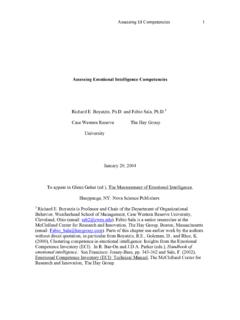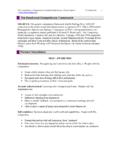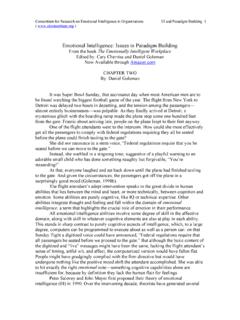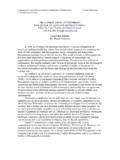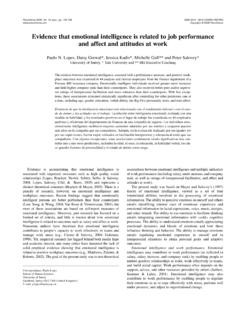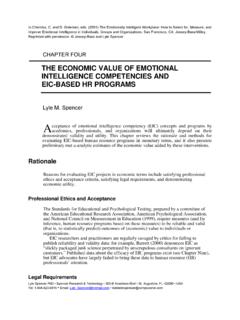Transcription of guidelines for best practice - Emotional intelligence
1 The Consortium for Research on Emotional intelligence in Organizations guidelines ( ) 1 guidelines for best practice The following 22 guidelines represent the best current knowledge about how to promote Emotional intelligence in the workplace. They apply to any development effort in which social and Emotional learning is a goal. This would include most management and executive development efforts as well as training in supervisory skills, diversity, teamwork, leadership, conflict management, stress management, sales, customer relations, etc.
2 These guidelines are based on an exhaustive review of the research literature in training and development, counseling and psychotherapy, and behavior change. The guidelines are additive and synergistic; to be effective, social and Emotional learning experiences need not adhere to all of these guidelines , but the chances for success increase with each one that is followed. The guidelines are divided into four phases that correspond to the four phases of the development process: preparation, training, transfer and maintenance, and evaluation.
3 Each phase is important. These guidelines were developed for the Consortium by Daniel Goleman and Cary Cherniss, with the assistance of Kim Cowan, Rob Emmerling, and Mitchel Adler. If you are interested in the full technical report that includes all the supporting research for each guideline, you view the full technical report online or download the document in Word format from. The address of the Consortium s Web site is Paving the Way 1. Assess the organization s needs: Determine the competencies that are most critical for effective job performance in a particular type of job.
4 In doing so, use a valid method, such as comparison of the behavioral events interviews of superior performers and average performers. Also make sure the competencies to be developed are congruent with the organization s culture and overall strategy. 2. Assess the individual: This assessment should be based on the key competencies needed for a particular job, and the data should come from multiple sources using multiple methods to maximize credibility and validity. 3. Deliver assessments with care: Give the individual information on his/her strengths and weaknesses.
5 In doing so, try to be accurate and clear. Also, allow plenty of time for the person to digest and integrate the information. Provide the feedback in a safe and supportive environment in order to minimize resistance and defensiveness. But also avoid making excuses or downplaying the seriousness of deficiencies. The Consortium for Research on Emotional intelligence in Organizations guidelines ( ) 24. Maximize learner choice: People are more motivated to change when they freely choose to do so.
6 As much as possible, allow people to decide whether or not they will participate in the development process, and have them set the change goals themselves. 5. Encourage people to participate: People will be more likely to participate in development efforts if they perceive them to be worthwhile and effective. Organizational policies and procedures should encourage people to participate in development activity, and supervisors should provide encouragement and the necessary support. Motivation also will be enhanced if people trust the credibility of those who encourage them to undertake the training.
7 6. Link learning goals to personal values: People are most motivated to pursue change that fits with their values and hopes. If a change matters little to people, they won t pursue it. Help people understand whether a given change fits with what matters most to them. 7. Adjust expectations: Build positive expectations by showing learners that social and Emotional competence can be improved and that such improvement will lead to valued outcomes. Also, make sure that the learners have a realistic expectation of what the training process will involve.
8 8. Gauge readiness: Assess whether the individual is ready for training. If the person is not ready because of insufficient motivation or other reasons, make readiness the focus of intervention efforts. Doing the Work of Change 9. Foster a positive relationship between the trainers and learners: Trainers who are warm, genuine, and empathic are best able to engage the learners in the change process. Select trainers who have these qualities, and make sure that they use them when working with the learners.
9 10. Make change self-directed: Learning is more effective when people direct their own learning program, tailoring it to their unique needs and circumstances. In addition to allowing people to set their own learning goals, let them continue to be in charge of their learning throughout the program, and tailor the training approach to the individual s learning style. 11. Set clear goals: People need to be clear about what the competence is, how to acquire it, and how to show it on the job. Spell out the specific behaviors and skills that make up the target competence.
10 Make sure that the goals are clear, specific, and optimally challenging. The Consortium for Research on Emotional intelligence in Organizations guidelines ( ) 312. Break goals into manageable steps: Change is more likely to occur if the change process is divided into manageable steps. Encourage both trainers and trainees to avoid being overly ambitious. 13. Provide opportunities to practice : Lasting change requires sustained practice on the job and elsewhere in life. An automatic habit is being unlearned and different responses are replacing it.
